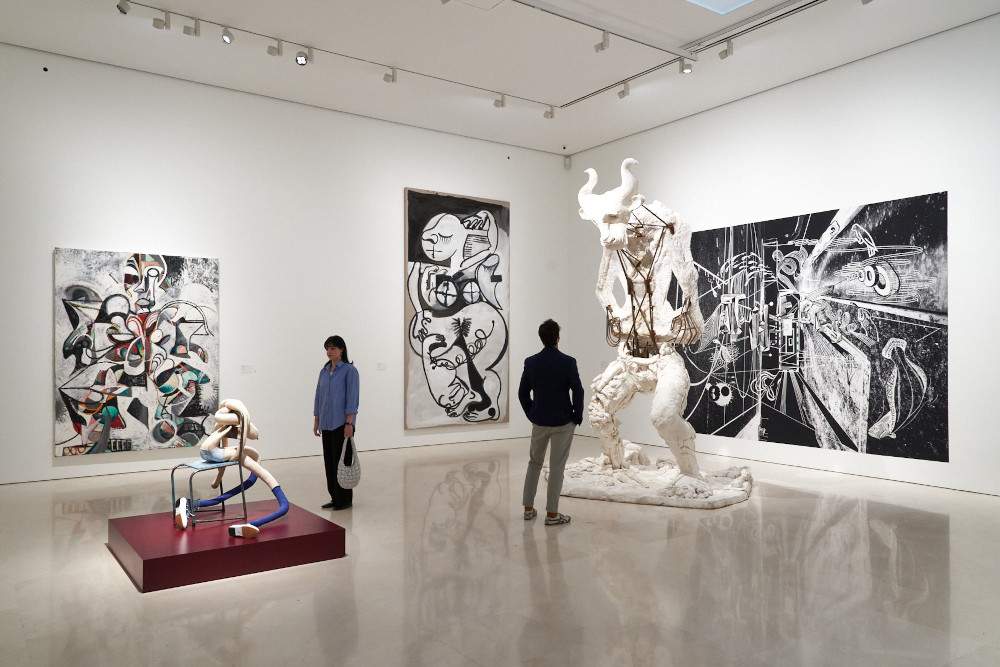At Museo Picasso Málaga, an exhibition investigates Picasso's echoes on the art world
From October 3, 2023 to March 31, 2024, the Museo Picasso Málaga will host the exhibition The Echo of Picasso, curated by Eric Troncy, which aims to analyze contemporary art through the dialogue that international artists have established with the art and figure of Pablo Picasso.
The exhibition brings together eighty-five works by more than fifty artists, including Picasso himself, Willem de Kooning, Jean-Michel Basquiat, Louise Bourgeois, and Jeff Koons, to analyze a twofold dialogue: that which some established when Picasso was still alive and the influence of Picasso that contemporary artists have recognized on their works. Indeed, the artist had a profound impact on the art world: therefore, it could be argued that there was no artist before him who had a massive following of followers and admirers, as well as critics. Fifty years after the artist’s death, it seems appropriate to speak of “echoes,” both in terms of chronological distance and the resonance produced by new voices.
Therefore, on the one hand, the exhibition presents Picasso’s work alongside that of artists who have acknowledged his influence on their work, such as Francis Bacon, Maria Lassnig, George Condo, or Martin Kippenberger; on the other hand, contemporary artists such as Claire Tabouret, Rashid Johnson, Brian Calvin, and Farah Atassi are presented, seventeen of whom created their works specifically for the exhibition project, so they will be exhibited for the first time.
Among the eighty-five works on display, eighteen are by Pablo Picasso himself, most notably the large-scale canvas The Massacre of Korea from the Picasso Museum in Paris, which has not been back to Spain for fifteen years.
The exhibition at the Picasso Museum Málaga is based precisely on theecho of Picasso’s artistic practices in the contemporary and, especially, in today’s globalized art world. The uniqueness of this exhibition, Troncy explains, is due to the fact that “on the one hand it explores Picasso’s extraordinary presence in our imagination and, on the other hand, the profound sign that his constant search for new forms of artistic expression has left room for the concerns of the most recent generations.”
The exhibition explores the visual experience of these resonances through exceptional loans of works by artists from the 1920s to the present. This exhibition project offers a dreamlike journey through the echoes of Pablo Picasso’s experiments experienced through various eras, styles and generations. The public is invited to rethink the artist’s work and rediscover a modern Picasso through the gaze of artists from other generations.
The museum offers an audio guide service, in Spanish and English, to help the public learn more about the works on display and the exhibition itinerary, sometimes with quotes from the artists themselves. There will also be workshops for adults on some of the artistic techniques in the exhibition, as well as a series of meetings with artists and experts. The cultural and educational proposal will be enriched by an extensive program for children and families, another for all levels of the educational community, and a social participation project aimed at women in vulnerable situations.
Accompanying the exhibition is a comprehensive catalog of biographies of all the artists featured; it also includes a text by the curator and a paper by Picasso expert Michael Fitzgerald. Picasso’s Echo is part of the international program of celebrations of the 50th anniversary of the artist’s death and is organized in collaboration with the Almine and Bernard Ruiz-Picasso Foundation, as well as with the support of the Musée National Picasso-Paris and the Spanish National Commission for the Commemoration of the 50th Anniversary of the Death of Pablo Picasso. The exhibition at the Picasso Museum Málaga is produced in collaboration with the “la Caixa” Foundation.
 |
| At Museo Picasso Málaga, an exhibition investigates Picasso's echoes on the art world |
Warning: the translation into English of the original Italian article was created using automatic tools. We undertake to review all articles, but we do not guarantee the total absence of inaccuracies in the translation due to the program. You can find the original by clicking on the ITA button. If you find any mistake,please contact us.



























